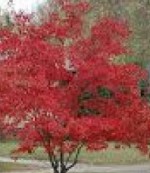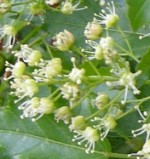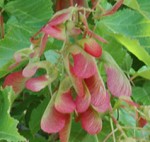 Amur maple is a small deciduous tree native to parts of Siberia, Manchuria, and Japan but is grown in North America where it has become invasive in some areas. It is usually multi-stemmed, broadly oval or globe-shaped, and bears clusters of small fragrant pale yellow flowers in early spring. Winged fruits called samaras are red and provide summer color and persist into winter. The medium to dark green three-lobed leaves are early to leaf out in spring and early to turn red or yellow in the fall, but remain on the tree only briefly once they have changed color. Amur maple adapts to a wide range of soils, is tolerant of wind, drought and some shade, transplants easily and tolerates heavy pruning It is cold hardy and makes a useful substitute for Japanese maple (Acer palmatum) in cold areas. A good specimen or patio tree, it can be used as a hedge or screen, grows well in a container, and is used for bonsai in Japan.
Amur maple is a small deciduous tree native to parts of Siberia, Manchuria, and Japan but is grown in North America where it has become invasive in some areas. It is usually multi-stemmed, broadly oval or globe-shaped, and bears clusters of small fragrant pale yellow flowers in early spring. Winged fruits called samaras are red and provide summer color and persist into winter. The medium to dark green three-lobed leaves are early to leaf out in spring and early to turn red or yellow in the fall, but remain on the tree only briefly once they have changed color. Amur maple adapts to a wide range of soils, is tolerant of wind, drought and some shade, transplants easily and tolerates heavy pruning It is cold hardy and makes a useful substitute for Japanese maple (Acer palmatum) in cold areas. A good specimen or patio tree, it can be used as a hedge or screen, grows well in a container, and is used for bonsai in Japan.
Type: Deciduous tree
Outstanding Feature: Fall coloration
 Form: Broad oval or globe-shaped
Form: Broad oval or globe-shaped
Growth Rate: Slow
Bloom: Clusters of small, pale yellow fragrant flowers in early spring
Size: 15-20’ H x 15-20’ W
Light: Full sun to partial shade
Soil: Average, moist to dry, well-drained; drought tolerant once established
Hardiness: Zones 3-8
Care: may need pruning to maintain tree form.
Pests and Diseases: Generally pest and disease free but susceptible to verticillium wilt
Propagation: Seed, softwood cuttings
Outstanding Selections:
 ‘Embers’- (Bright red autumn color and red fruit)
‘Embers’- (Bright red autumn color and red fruit) ‘Flame’- ( Good red autumn color and red fruit)
‘Flame’- ( Good red autumn color and red fruit) ‘Red Fruit’- (bright red fruit).
‘Red Fruit’- (bright red fruit).